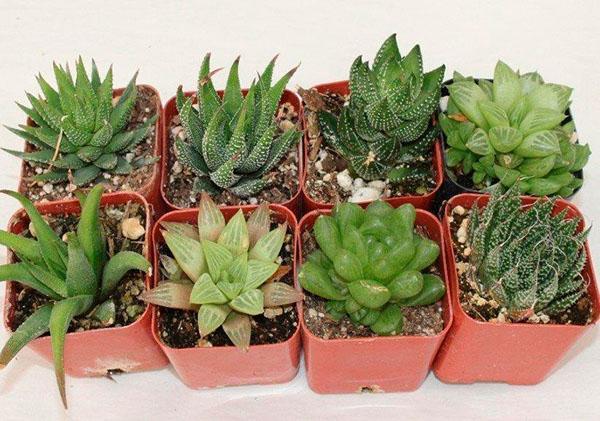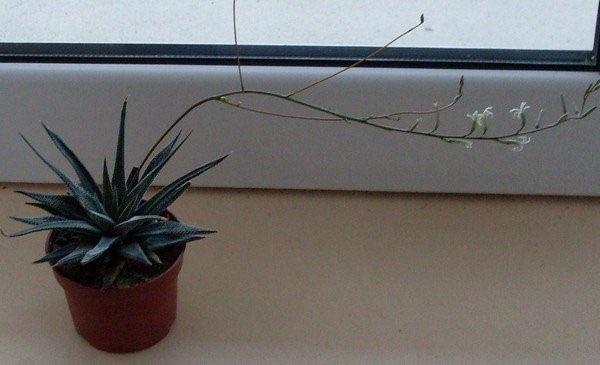Caring for Hawortia at home: a memo to the florist
 Haworthia is a small succulent plant. In order for it to please with the bright color of the leaves and decorativeness, care for haworthia at home should be carried out according to all the rules. The plant got its name after the famous botanist E. Haworth, who studied it, and carried out the classification.
Haworthia is a small succulent plant. In order for it to please with the bright color of the leaves and decorativeness, care for haworthia at home should be carried out according to all the rules. The plant got its name after the famous botanist E. Haworth, who studied it, and carried out the classification.
Description of the plant

In many succulent species, fleshy, dense leaves form rosettes on the surface of the soil, while some have a short stem.
The peculiarity of Haworthia is the accumulation of moisture in the leaves. In nature, this property helps the plant survive periods of drought.
Some types of haworthia have white bulges on the surface of the leaf plates, giving the succulent a decorative effect. Haworthia's flowers are small.
More often than others, you can find such varieties:
- striped;

- pearl;

- haworthy Reinwardt.

The most common species in floriculture is Haworthia striped. It is a stemless plant with dark green leaves on which small white tubercles are located. Merging, they form original stripes. An adult plant can grow up to 0.2 m in diameter.
Haworthia is not poisonous. In folk medicine, the plant is used as an antiseptic. A sheet cut in half for the fastest healing and disinfection can be applied to the wound.
Home care for haworthia
 Haworthia is an ornamental deciduous plant that grows well in bright sunny rooms. West, east and south windows are most suitable for placing a flower pot. In this case, it is advisable to avoid hitting the scorching rays on the leaves.
Haworthia is an ornamental deciduous plant that grows well in bright sunny rooms. West, east and south windows are most suitable for placing a flower pot. In this case, it is advisable to avoid hitting the scorching rays on the leaves.
Undemanding to the conditions of keeping and caring for haworthia at home allows even novice growers to grow succulent.
Temperature regime of maintenance and watering
 This southern plant thrives in warm sunny rooms. Since a succulent does not need a lot of water, it is enough to moisten only the top layer of the earth.
This southern plant thrives in warm sunny rooms. Since a succulent does not need a lot of water, it is enough to moisten only the top layer of the earth.
In winter, Hawortia is rarely watered - once a month. At the same time, other conditions of detention are created with a lower temperature - up to + 12 ° C. Whether it is possible to keep the Hawortia at home depends on the availability of sunny windows.
If the plant has been in partial shade for a long time, then accustoming it to sunlight should take place gradually, starting from several hours a day. This will avoid burning the leaves.
Soil preparation and containers
 For a plant with a small root system, wide, shallow flower pots are suitable, in which they organize good drainage.
For a plant with a small root system, wide, shallow flower pots are suitable, in which they organize good drainage.
The soil for haworthia is prepared as follows:
- Combine turf and deciduous land in equal proportions.
- Fine gravel is added 1/3 of the resulting volume. In the absence of gravel, it can be replaced with crushed brick.
For planting a plant, you can purchase a ready-made mixture marked "for cacti" and add fine gravel to it.
Fertilization
 Top dressing of Haworthia is needed from mid-spring to late summer. With the arrival of autumn, fertilization is stopped. Fertilizers are suitable for feeding the plant, which are intended for cactus... But their concentration should be half less than indicated in the instructions for use.
Top dressing of Haworthia is needed from mid-spring to late summer. With the arrival of autumn, fertilization is stopped. Fertilizers are suitable for feeding the plant, which are intended for cactus... But their concentration should be half less than indicated in the instructions for use.
It is better to "underfeed" with fertilizers than "overfeed" Hawortia.
When to transplant
 With the growth of the plant, a Haworthia transplant will be needed. For young outlets, it must be carried out annually, for adult plants - as needed, about once every 3 or 2 years, when the previous capacity becomes small.
With the growth of the plant, a Haworthia transplant will be needed. For young outlets, it must be carried out annually, for adult plants - as needed, about once every 3 or 2 years, when the previous capacity becomes small.
The size of the flowerpot should match the size of the plant itself. If the capacity is too large, moisture stagnation in the root system is possible, which is not desirable for a succulent.
Reproduction: which way to choose

All types of Haworthia reproduce in several ways:
- offspring;
- sheet;
- seeds.
|
P / p No.
|
Breeding method |
Features of the method breeding |
| | Offspring | In order to transplant a young plant, it is enough to release the roots of the "baby" and transplant the young plant into a new pot. This is the simplest method of propagation, in which the new plant already has a separate root system and a rosette of leaves. |
| | Sheet | Reproduction of haworthia can be carried out with a leaf, which is separated from an adult bush. It is left to lie down for 2 days to dry the cut. After that, the leaf is planted in moist, loose soil. Do not water for 3-4 weeks. During this period, the leaf should have roots. |
| | Seeds | This breeding method is laborious and time consuming. It takes too long before the new plant is formed. Another disadvantage is the low germination rate of seed. |
The easiest way to reproduce Haworthia is to separate the "children", the most laborious and difficult is to grow from seeds.
Pests and diseases
 Haworthia cactus is very rarely affected by pests. It can be attacked by a mealybug, spider mite, aphid or scale insect. To eliminate the pest, it is enough to rinse the leaves of the plant with a mild soapy solution. If such treatment is not successful, a systemic poison is used.
Haworthia cactus is very rarely affected by pests. It can be attacked by a mealybug, spider mite, aphid or scale insect. To eliminate the pest, it is enough to rinse the leaves of the plant with a mild soapy solution. If such treatment is not successful, a systemic poison is used.
Improper care can lead to plant diseases:
- excessive watering;
- keeping in the cold;
- a lack of lighting or, conversely, being under the scorching sun rays;
- acidity of the soil.
Caring for haworthia at home is a simple process that is available even to a novice florist. With proper observance of the conditions of maintenance, the plant will grow well and give new shoots.